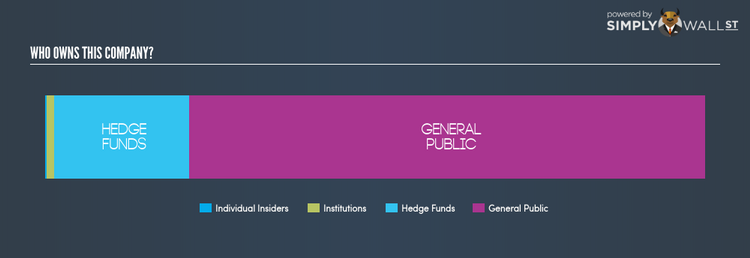Who Are Yatra Capital Limited’s (AMS:YATRA) Major Shareholders?

In this article, I will take a quick look at Yatra Capital Limited’s (ENXTAM:YATRA) recent ownership structure – an unconventional investing subject, but an important one. When it comes to ownership structure of a company, the impact has been observed in both the long-and short-term performance of shares. Differences in ownership structure of companies can have a profound effect on how management’s incentives are aligned with shareholder returns, which is why we’ll take a moment to analyse YATRA’s shareholder registry.
See our latest analysis for Yatra Capital
Institutional Ownership
Institutional investors typically buy and sell shares in large magnitudes which can significantly sway the share price, especially when there are relatively small amounts of shares available on the market to trade. Generally, an institutional ownership of 1.09%, in the case of YATRA, should not concern investors in terms of high stock volatility. But investors should also check whether hedge funds, mostly active investors with a short-term horizon, have a significant stake. They own 20.49% of YATRA’s outstanding shares, enough to cause a spike in volatility, at least in the short-term. However, I would also examine the rest of its ownership structure in more detail to determine how the company’s major shareholders can affect its investment case.
Insider Ownership
I find insiders are another important group of stakeholders, who are directly involved in making key decisions related to the use of capital. In essence, insider ownership is more about the alignment of shareholders’ interests with the management. YATRA insiders hold a minor stake in the company, which somewhat aligns their interests with that of shareholders. However, a higher level of insider ownership has been linked to management executing on high-returning projects instead of expansion projects for the sake of apparent growth. It would also be interesting to check what insiders have been doing with their shareholding recently. Insider buying can be a positive indicator of future performance, but a selling decision can be simply driven by personal financial requirements.
General Public Ownership
A big stake of 78.06% in YATRA is held by the general public. With this size of ownership, retail investors can collectively play a role in major company policies that affect shareholders returns, including executive remuneration and the appointment of directors. They can also exercise the power to decline an acquisition or merger that may not improve profitability.
Next Steps:
While institutional ownership in YATRA is low, active hedge funds still have a significant stake in the company. Their ownership is a non-fundamental factor, which can impact YATRA’s price volatility in the short-term, considering this group investors may come under pressure to deliver in the short term. It is important that YATRA offers enough margin of safety in order to avoid a significant portfolio impact resulting from a sustained sell-off and drop in share value. However, ownership structure should not be the only determining factor when you’re building an investment thesis for YATRA. Rather, you should be examining fundamental factors such as the intrinsic valuation, which is a key driver of Yatra Capital’s share price. I urge you to complete your research by taking a look at the following:
1. Financial Health: Is YATRA’s operations financially sustainable? Balance sheets can be hard to analyze, which is why we’ve done it for you. Check out our financial health checks here.
2. Past Track Record: Has YATRA been consistently performing well irrespective of the ups and downs in the market? Go into more detail in the past performance analysis and take a look at the free visual representations of YATRA’s historicals for more clarity.
3. Other High-Performing Stocks: Are there other stocks that provide better prospects with proven track records? Explore our free list of these great stocks here.
NB: Figures in this article are calculated using data from the last twelve months, which refer to the 12-month period ending on the last date of the month the financial statement is dated. This may not be consistent with full year annual report figures.
To help readers see pass the short term volatility of the financial market, we aim to bring you a long-term focused research analysis purely driven by fundamental data. Note that our analysis does not factor in the latest price sensitive company announcements.
The author is an independent contributor and at the time of publication had no position in the stocks mentioned.

